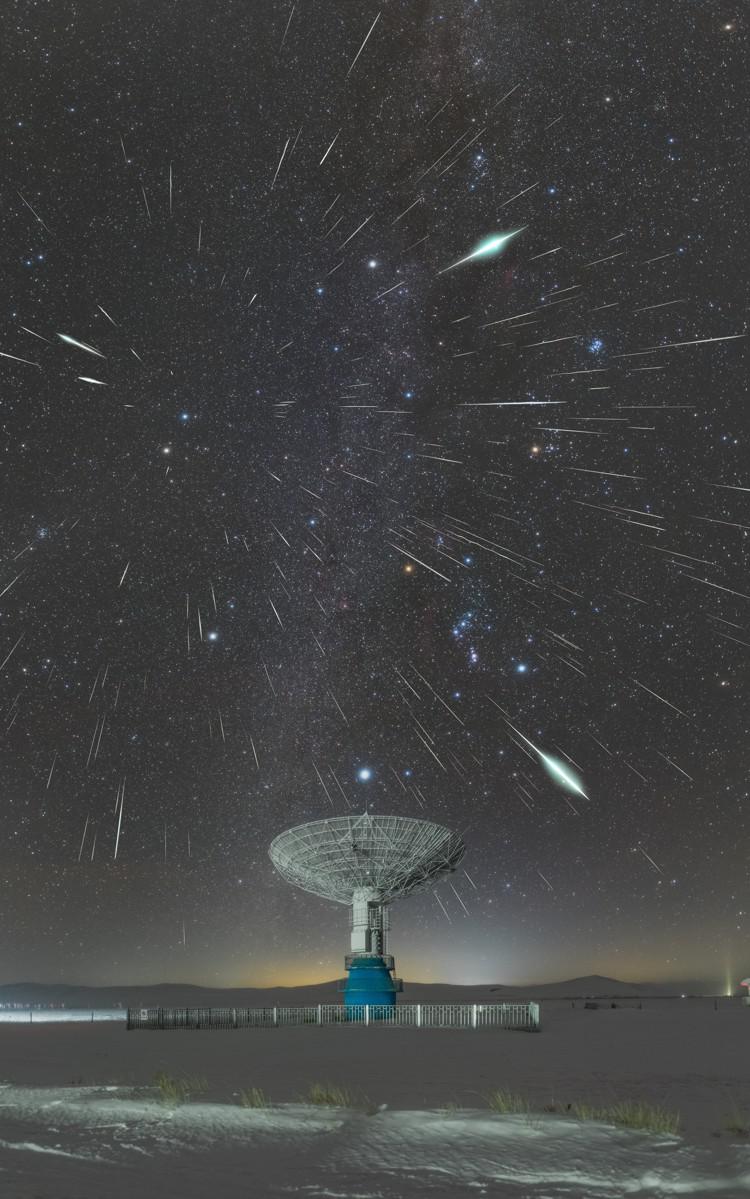This page describes an image Pioggia di meteore dei Gemelli, di Hao Yin, Cina
Image caption:
Terzo posto al concorso di astrofotografia IAU OAE 2021, categoria Piogge meteoriche.
Mentre la Terra viaggia intorno al Sole, può incrociare il percorso di detriti lasciati da una cometa o, più raramente, da un asteroide. Questi detriti entrano nell'atmosfera ad alta velocità, producendo bellissime tracce mentre bruciano nel cielo a causa dell'attrito con l'atmosfera. L'immagine cattura la pioggia di meteore Geminidi, così chiamata perché il punto di radiante si trova in cielo, nella costellazione dei Gemelli. Le particelle che compongono la pioggia di meteoriti viaggiano a velocità simili tra loro e con traiettorie parallele, il che provoca un effetto prospettico, come se il flusso irradiasse da un unico punto nel cielo, noto come punto radiante. Questa immagine, scattata nel dicembre 2020 in Cina, mostra chiaramente questa prospettiva. Si tratta di uno sciame molto prolifico, tanto che nelle ultime apparizioni è stato possibile osservare oltre cento meteoriti all'ora. Questa pioggia di meteoriti è una delle poche associate non a una cometa, ma ad un asteroide - 3200 Phaeton, che potrebbe essere una cometa che ha perso tutte le sue sostanze volatili. Questa immagine mostra il gran numero di meteore che si possono osservare in questo sciame, che ha luogo ogni anno, sempre a dicembre. L'immagine mostra anche una delle costellazioni più importanti del cielo notturno, Orione, facilmente visibile grazie alle tre stelle in diagonale che formano la Cintura di Orione e alla stella rosso-arancio Betelgeuse. Proprio sopra l'antenna c'è un punto luminoso: si tratta di Sirio, la stella più brillante del cielo notturno e parte della costellazione del Cane Maggiore. La macchia bluastra sfocata, a ore 2 circa, è l'ammasso stellare delle Pleiadi.
Scroll to captions in other languages
Image credit:
Hao Yin/IAU OAE
Stato di traduzione della didascalia: Approvato da un revisore
traduttori della didascalia: Giuliana Giobbi
revisori della didascalia: Rodolfo Canestrari
DOI: 10.5281/zenodo.5367501
Termini di glossario connessi:
Stella cadente
Categorie:
Astronomia ad occhio nudo
Image license: Creative Commons Attribuzione 4.0 Internazionale (CC BY 4.0) Creative Commons Attribuzione 4.0 Internazionale (CC BY 4.0) icone
If you notice a factual error in this caption or an error in any of its translations then please get in touch.
Didascalie in lingue diverse:
Image caption: Third place in the 2021 IAU OAE Astrophotography Contest, category Meteor showers.
As the Earth travels around the Sun, it may cross the path of debris left behind by a comet or, more rarely, by an asteroid. These debris enter the atmosphere at high speed, producing beautiful tracks as they burn in the sky due to friction with the atmosphere. The image captures the Geminid meteor shower, named because the radiant point is located on the sky in the constellation Gemini. The particles composing the meteor shower travel at similar speed and in parallel trajectories, which causes a perspective effect like if the stream radiates from one single point in the sky, which is known as the radiant point. This image, taken in December 2020 in China, clearly shows this perspective. This is a very prolific shower, in such a way that over one hundred meteorites could be seen per hour in recent appearances. This meteor shower is one of the few associated not with a comet, but with an asteroid – 3200 Phaeton, which might be a comet that lost all its volatile material. This image shows the large number of meteors that can be observed in this shower, which always happens in December every year. The image also shows one of the most prominent constellations in the night sky, Orion, easily seen by the three stars in a diagonal making up Orion’s Belt, and the red-orange star Betelgeuse. Right above the dish is a bright point and that is the Sirius, the brightest star in the night sky and part of the constellation Canis Major. The fuzzy bluish smudge at around 2 ‘o’ clock is the Pleiades star cluster.
Image credit: Hao Yin/IAU OAE
Termini di glossario connessi: Shooting Star
Image caption: Troisième place au concours d'astrophotographie 2021 de l'UAI OAE, catégorie pluies de météores.
Lorsque la Terre voyage autour du Soleil, elle peut croiser la trajectoire de débris laissés par une comète ou, plus rarement, par un astéroïde. Ces débris pénètrent dans l'atmosphère à grande vitesse, produisant de magnifiques traces lorsqu'ils brûlent dans le ciel en raison de la friction avec l'atmosphère. L'image capture la pluie de météores des Géminides, ainsi nommée parce que le point radiant est situé dans la constellation des Gémeaux. Les particules qui composent la pluie de météores se déplacent à la même vitesse et selon des trajectoires parallèles, ce qui produit un effet de perspective comme si la pluie rayonnait à partir d'un seul point dans le ciel, connu sous le nom de point radiant. Cette image, prise en décembre 2020 en Chine, montre clairement cette perspective. Il s'agit d'une pluie très prolifique, de telle sorte que plus d'une centaine de météorites ont pu être observées par heure lors d'apparitions récentes. Cette pluie de météores est l'une des rares à être associée non pas à une comète, mais à un astéroïde - 3200 Phaeton, qui pourrait être une comète ayant perdu toute sa matière volatile. Cette image montre le grand nombre de météores qui peuvent être observés lors de cette pluie, qui a lieu chaque année en décembre. L'image montre également l'une des constellations les plus importantes du ciel nocturne, Orion, facilement visible grâce aux trois étoiles en diagonale qui forment la ceinture d'Orion, et à l'étoile rouge-orange Bételgeuse. Juste au-dessus du réflecteur paraboliquela se trouve un point lumineux : il s'agit de Sirius, l'étoile la plus brillante du ciel nocturne, qui fait partie de la constellation Canis Major. La tache bleuâtre floue à environ 2 heures est l'amas d'étoiles des Pléiades.
Image credit: Hao Yin/IAU OAE
Termini di glossario connessi: Étoile filante Caption translation status: Non ancora approvato da un revisore
Caption translators: Rulx Narcisse
Image caption: 2021 年国际天文学联合会 OAE 天文摄影比赛流星雨类第三名。
地球绕太阳运行时,可能会穿过彗星或小行星(罕见)留下的碎片的轨迹。这些碎片高速进入大气层,与大气层摩擦后在天空中燃烧,形成美丽的轨迹。这张图片拍摄的是双子座流星雨,因辐射点位于双子座而得名。组成流星雨的粒子以相似的速度平行移动,这就产生了一种透视效果,就好像流星雨从天空中的一个点辐射出来,这就是所谓的辐射点。这张于 2020 年 12 月在中国拍摄的照片清晰地展示了这种透视效果。这是一个非常活跃的流星雨,最近每小时可以看到一百多颗。双子座流星雨是少数几个与彗星无关的流星雨之一,它与一颗小行星--3200 Phaeton 有关,这颗小行星可能是一颗失去了所有挥发性物质的彗星。这张图片展示了双子座流星雨中可以观测到的大量流星,通常发生在每年 12 月。这张图片还显示了夜空中最显眼的星座之一--猎户座,猎户座腰带上成斜线的三颗星和橘红色的参宿四很容易就能看到。望远镜的正上方有一个亮点,那就是天狼星,夜空中最亮的恒星,也是大犬座的一部分。2 点钟方向的模糊蓝斑是昴星团。
Image credit: Hao Yin/IAU OAE
Termini di glossario connessi: 流星 Caption translation status: Non ancora approvato da un revisore
Caption translators: Hu Xueying
Image caption: 2021 年國際天文學聯合會 OAE 天文攝影比賽流星雨類第三名。
地球繞太陽運行時,可能會穿過彗星或小行星(罕見)留下的碎片的軌跡。這些碎片高速進入大氣層,與大氣層摩擦後在天空中燃燒,形成美麗的軌跡。這張圖片拍攝的是雙子座流星雨,因輻射點位於雙子座而得名。組成流星雨的粒子以相似的速度平行移動,這就產生了一種透視效果,就好像流星雨從天空中的一個點輻射出來,這就是所謂的輻射點。這張於 2020 年 12 月在中國拍攝的照片清晰地展示了這種透視效果。這是一個非常活躍的流星雨,最近每小時可以看到一百多顆。雙子座流星雨是少數幾個與彗星無關的流星雨之一,它與一顆小行星--3200 Phaeton 有關,這顆小行星可能是一顆失去了所有揮發性物質的彗星。這張圖片展示了雙子座流星雨中可以觀測到的大量流星,通常發生在每年 12 月。這張圖片還顯示了夜空中最顯眼的星座之一--獵戶座,獵戶座腰帶上成斜線的三顆星和橘紅色的參宿四很容易就能看到。望遠鏡的正上方有一個亮點,那就是天狼星,夜空中最亮的恆星,也是大犬座的一部分。2 點鐘方向的模糊藍斑是昴星團。
Image credit: Hao Yin/IAU OAE
Termini di glossario connessi: 流星 Caption translation status: Non ancora approvato da un revisore
Caption translators: An automated transliteration from the simplified Chinese translation by - Hu Xueying









